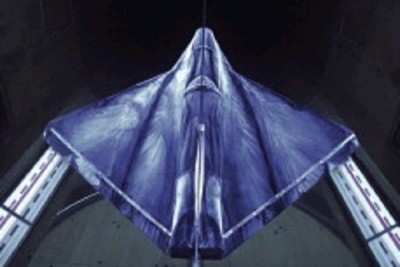Wed, Sep 09, 2009
Future Engineers Prepare To Test Future UAS
 Engineering apprentices at BAE
Systems are adding the final touches to an experimental aircraft
that will test radical new methods of controlling it in flight.
Engineering apprentices at BAE
Systems are adding the final touches to an experimental aircraft
that will test radical new methods of controlling it in flight.
The demonstrator has been built under a project to explore
technologies destined for use on future unmanned aircraft systems
(UAS). Known as Demon, the aircraft is the outcome of a project
called FLAVIIR (Flapless Air Vehicle Integrated Industrial
Research). This five-year program costing nearly $11 million is
jointly funded by BAE Systems and the Engineering and Physical
Sciences Research Council (EPSRC).
FLAVIIR brings together 10 universities, led by Cranfield
University and BAE Systems. Its major focus is to develop the
technologies needed to build a low-cost, low maintenance UAS with
no conventional control surfaces, such as wing flaps and without
losing any performance compared to conventional aircraft.
Matt Pearson, Demon Delivery Manager, said the aircraft is a 176
pound, jet-powered UAS with a wing span of about 8 feet. It was
designed at Cranfield University, with the support of the other
partner institutions, and manufacture and assembly has been carried
out jointly by Cranfield's Composite Manufacturing Center and BAE
Systems apprentices.

BAE Demon Photo Courtesy BAE
Systems
Matt described the apprentices working on Demon as the
"engineers of the future, working on the technology of the future".
He said they had taken the air frame, fitted it out, and added all
the wiring and electrical systems needed to create a working,
functioning aircraft. Now in the final stages of assembly, Demon
will make its first test flights later this year. The project has
developed a number of ways of doing away with flaps and the flight
tests will evaluate which of these is best.
Richard Williams, Program Director Future Capability, is
delighted with the Demon's progress: "Projects such as Demon have
several advantages for BAE Systems. "They help to ensure we get the
greatest benefit from our invested research money and offer
continued benefit from the increase in the capability and
competencies of the universities involved."
More News
Aero Linx: Model Aeronautical Association of Australia MAAA clubs are about fun flying, camaraderie and community. For over 75 years, the MAAA has been Australia’s largest fl>[...]
Touchdown Zone Lighting Two rows of transverse light bars located symmetrically about the runway centerline normally at 100 foot intervals. The basic system extends 3,000 feet alon>[...]
“Discovery and innovation are central to our mission at Virgin Galactic. We’re excited to build on our successful record of facilitating scientific experiments in subor>[...]
How To Get A Story On Aero-TV News/Feature Programming How do I submit a story idea or lead to Aero-TV? If you would like to submit a story idea or lead, please contact Jim Campbel>[...]
Student Pilot Reported That During Rotation, “All Of A Sudden The Back Of The Plane Kicked To The Right..." Analysis: The student pilot reported that during rotation, “>[...]
 ANN's Daily Aero-Linx (05.02.24)
ANN's Daily Aero-Linx (05.02.24) ANN's Daily Aero-Term (05.02.24): Touchdown Zone Lighting
ANN's Daily Aero-Term (05.02.24): Touchdown Zone Lighting Aero-News: Quote of the Day (05.02.24)
Aero-News: Quote of the Day (05.02.24) ANN FAQ: Contributing To Aero-TV
ANN FAQ: Contributing To Aero-TV NTSB Final Report: Cirrus Design Corp SR20
NTSB Final Report: Cirrus Design Corp SR20



